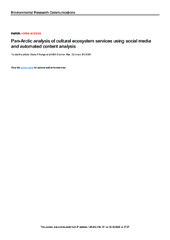Pan-Arctic analysis of cultural ecosystem services using social media and automated content analysis
Permanent lenke
https://hdl.handle.net/10037/19528Dato
2020-07-02Type
Journal articleTidsskriftartikkel
Peer reviewed
Sammendrag
In the Arctic, as in many parts of the world, interactions with the natural world are an important part of people's experience and are often recorded in photographs. Emerging methods for automated content analysis of social media data offers opportunities to discover information on cultural ecosystem services from photographs across large samples of people and countries. We analysed over 800 000 Flickr photographs using Google's Cloud Vision algorithm to identify the components of the natural environment most photographed and to map how and where different people interact with nature across eight Arctic countries. Almost all (91.1%) of users took one or more photographs of biotic nature, and such photos account for over half (53.2%) of Arctic photos on Flickr. We find that although the vast majority of Arctic human-nature interactions occur outside protected areas, people are slightly more likely to photograph nature inside protected areas after accounting for the low accessibility of Arctic protected areas. Wildlife photographers travel further from roads than people who take fewer photographs of wildlife, and people venture much further from roads inside protected areas. A large diversity of nature was reflected in the photographs, from mammals, birds, fish, fungi, plants and invertebrates, signalling an untapped potential to connect and engage people in the appreciation and conservation of the natural world. Our findings suggest that, despite limitations, automated content analysis can be a rapid and readily accessed source of data on how and where people interact with nature, and a large-scale method for assessing cultural ecosystem services across countries and cultures.
Forlag
IOP PublishingSitering
Runge, Hausner, daigle, Monz. Pan-Arctic analysis of cultural ecosystem services using social media and automated content analysis. Environmental Research Communications (ERC). 2020;2(7)Metadata
Vis full innførselSamlinger
Copyright 2020 The Author(s)


 English
English norsk
norsk